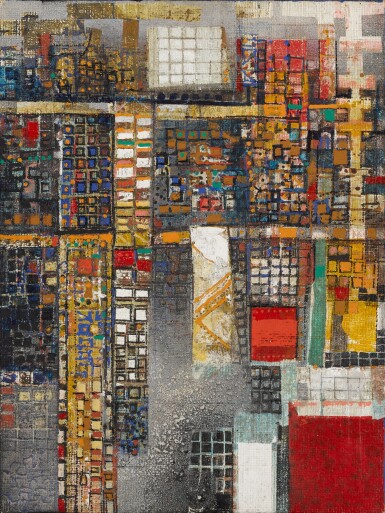
Property from the Collection of Mr. & Mrs. Quincy Troupe
Alexander Skunder Boghossian
New York Scroll #1
Lot Closed
March 22, 04:36 PM GMT
Estimate
10,000 - 15,000 GBP
Lot Details
Description
Alexander Skunder Boghossian
Ethiopian
1937-2003
New York Scroll #1
titled and dated 1983 (on the reverse)
oil on board
45.7 by 60.9cm., 18 by 24in.
framed: 51.4 by 66.7cm., 20¼ by 26¼in.
Acquired directly from the artist by the present owner in c.1986
In 1980, Skunder Boghossian developed a firm fascination with porous surfaces and once said to Thomas Porter, African-American jazz scholar, "I like porous surfaces, especially things that remain in sands…things that witness their time". Skunder used illuminated parchment scrolls made by Ethiopian debteras (a religious figure in the Ethiopian and Eritrean Orthodox Tewahedo Churches) as a principle inspiration for his painting, fascinated by their ethereal qualities.
Skunder indicates that the interlocking and weaving, indicative of Ethiopian illuminated manuscripts, is called kulflfu and the technique is portrayed in his work to create a rich and textured surface. Skunder’s interest in time-worn materials is evident in the background as the forms fade between shapes, symbols and script, providing an underlying rhythm to the work.
Here it is important to note Skunder’s intimate relationship with music and particularly jazz. “Jazz,” says his friend, poet and art critic Solomon Deressa “is so fully assimilated into Skunder’s myths of birth, change and dissolution that to this day I cannot look at Skunder’s painting without hearing Sonny Rollins or Coltrane or Miles Davis.” Indeed Skunder danced to the music as he painted.
Scrolls proved to be a life-long interest, even obsession, for Skunder. The free and dance-like qualities of Skunder’s work demonstrates his interest in objects constructed or uncovered by the unconscious mind whilst consistently standing as an icon of Africa’s modernism and political culture.
You May Also Like




